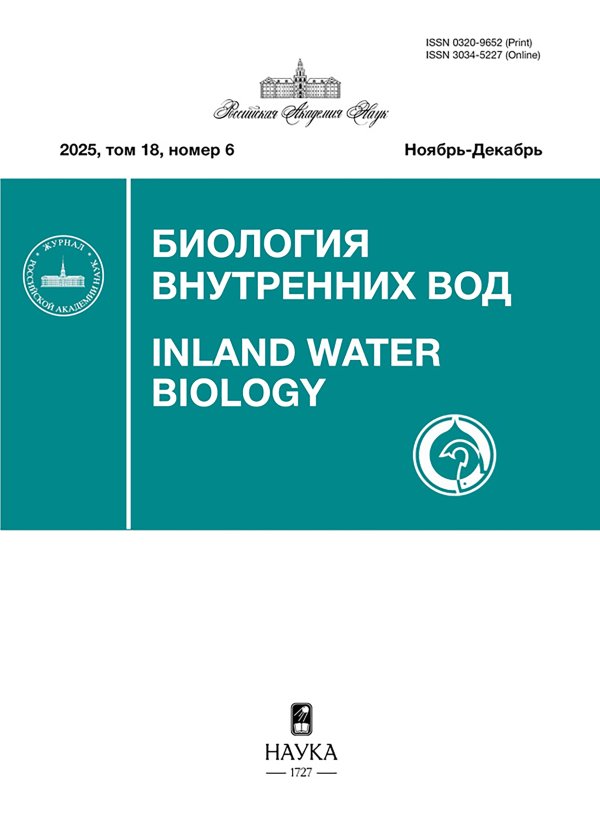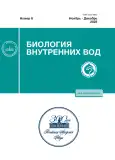Stable Differences in Growth Rates of Juvenile Triploid Oysters Crassostrea gigas
- Authors: Vialova O.Y.1
-
Affiliations:
- Kovalevsky Institute of Biology of the Southern Seas of Russian Academy of Sciences
- Issue: No 6 (2023)
- Pages: 777-783
- Section: БИОЛОГИЯ, МОРФОЛОГИЯ И СИСТЕМАТИКА ГИДРОБИОНТОВ
- URL: https://journals.rcsi.science/0320-9652/article/view/232372
- DOI: https://doi.org/10.31857/S0320965223060347
- EDN: https://elibrary.ru/LXGDHF
- ID: 232372
Cite item
Full Text
Abstract
The three groups of mollusks of the triploid Pacific oyster Crassostrea gigas from the Liman Donuzlav (Black Sea), differing in morphometric characteristics: fast growing (FG) – shell height (H) > 40 mm, medium growing (MG) – 15 mm < H < 40 mm and slow growing (SG) – H < 15 mm, were studied. The stable differences in the growth rates of juveniles of the same age were revealed. Mollusks of the FG group were the leaders in terms of weight gain and linear size throughout the study. The average daily increase in shell height in the studied mollusks ranged from 0.1 to 0.35 mm/day, with maximum values in June and September. Weight gain occurred with different intensity, on average in SG – 0.051 g/day, in MG – 0.168 g/day, in FG – 0.287 g/day. The peaks of this indicator were in August and September, reaching 0.12, 0.26 and 0.43 g/day, respectively. A negative allometry of the shell in height was obtained in slow–growing polyploid oysters (b = 2.17), in the other two other groups – a clear positive (for MG b = 3.23, for FG b = 3.80), i.e., the increase in mass was faster than linear growth in juveniles of the species. Polyploidy (triploidy) is suggested as the reason for the differences in the growth rates of the same-aged mollusks. The allometry indicator b can be used to identify growth features in the early stages of oyster development.
Keywords
About the authors
O. Yu. Vialova
Kovalevsky Institute of Biology of the Southern Seas of Russian Academy of Sciences
Author for correspondence.
Email: vyalova07@gmail.com
Russia, Sevastopol
References
- Вялова О.Ю. 2009. Первые результаты выращивания триплоидной тихоокеанской устрицы Crassostrea gigas в Черном море (Южный берег Крыма) // Экология моря. Вып. 79. С. 37.
- Вялова О.Ю. 2019. Рост и сроки получения товарной триплоидной устрицы в озере Донузлав (Черное море, Крым) // Морской биол. журн. Т. 4. № 1. С. 24. https://doi.org/10.21072/mbj.2019.04.1.03
- Жугайло С.С., Авдеева Т.М., Пугач М.Н., Аджиумеров Э.Н. 2018. Состояние качества водной среды донных отложений озера Донузлав в современный период // Водные биоресурсы и среда обитания. Т. 1. № 1. С. 32. http://hdl.handle.net/1834/14185
- Baillie Ch.J., Grabowski J.H. 2019. Factors affecting recruitment, growth and survival of the eastern oyster Crassostrea virginica across an intertidal elevation gradient in southern New England // Mar. Ecol. Progr. Ser. V. 609. P. 119. https://doi.org/10.3354/meps12830
- Barilléa L., Lerouxela A., Dutertrea M. et al. 2011. Growth of the Pacific oyster (Crassostrea gigas) in a high-turbidity environment: Comparison of model simulations based on scope for growth and dynamic energy budgets // J. Sea Res. V. 66. Iss. 4. P. 392. https://doi.org/10.1016/j.seares.2011.07.004
- Batista F., Leitão A., Fonseca V. et al. 2007. Individual relationship between aneuploidy of gill cells and growth rate in cupped oysters Crassostrea angulata, C. gigas and their reciprocal hybrids // J. Exp. Mar. Biol. Ecol. V. 352. Iss. 1. P. 226. https://doi.org/10.1016/j.jembe.2007.07.009
- Bayne B.L. 2000. Relations between variable rates of growth, metabolic costs and growth efficiencies in individual Sydney rock oysters (Saccostrea commercialis) // J. Exp. Mar. Biol. Ecol. V. 251. Iss. 2. P. 185. https://doi.org/10.1016/S0022-0981(00)00211-2
- Bayne B.L. 2004. Phenotypic flexibility and physiological tradeoffs in the feeding and growth of marine bivalve molluscs // Int. Comp. Biol. V. 44. Iss. 6. P. 425. https://doi.org/10.1093/icb/44.6.425
- Bertolini C., Brigolin D., Porporato E.M.D. et al. 2021. Testing a model of pacific oysters (Crassostrea gigas) growth in the Adriatic Sea: implications for aquaculture spatial planning // Sustainability. V. 13. P. 2. https://doi.org/10.3390/su13063309
- Bodenstein S., Walton W.C., Steury T.D. 2021. Effect of farming practices on growth and mortality rates in triploid and diploid eastern oysters Crassostrea virginica // Aquaculture Environ. Int. V. 13. P. 33. https://doi.org/10.3354/aei00387
- Brundu G., Pagani S., Graham Ph. 2021. The shell growth of Crassostrea gigas and Ostrea edulis in windy condition: a preliminary evaluation // Aquaculture Res. V. 52. P. 6802. https://doi.org/10.1111/are.15511
- Cogswell A.T., Kenchington E.L., Roach S.E. et al. 2006. Triploid bay scallops (Argopecten irradians): induction methodology, early gonadic development and growth // Can. Tech. Report Fish. Aquat. Sci. V. 2635.
- Dame R.F. 1972. Comparison of various allometric relationships in intertidal and subtidal American oysters // Fishery bulletin. V. 70. Iss. 4. P. 1121.
- Francis Pan T.C., Applebaum S.L., Manahan D.T. 2015. Genetically determined variation in developmental physiology of bivalve larvae (Crassostrea gigas) // Physiol. Biochem. Zool. V. 88. № 2. P. 128. https://doi.org/10.1086/679656
- Grangeré K., Ménesguen A., Lefebvre S. et al. 2009. Modelling the influence of environmental factors on the physiological status of the Pacific oyster Crassostrea gigas in an estuarine embayment; The Baie des Veys (France) // J. Sea Res. V. 62. P. 147.
- Guo X.M., Allen S.K. 1994. Viable tetraploids in the Pacific oyster (Crassostrea gigas Thunberg) produced by inhibiting polar body I in eggs from triploids // Mol. Mar. Biol. Biotechnol. V. 3. Iss. 1. P. 42.
- Hedgecock D., Lin J.Z., De Cola S. et al. 2007. Transcriptomic analysis of growth heterosis in larval Pacific oysters (Crassostrea gigas) // Proceedings of the National Academy of Sciences of the United States of America. V. 104. № 7. P. 2313. https://doi.org/10.1073/pnas.0610880104
- Leitão A., Boudry P., Thiriot-Quiévreux C. 2001. Negative correlation between aneuploidy and growth in thePacific oyster Crassostrea gigas: ten years of evidence // Aquaculture. V. 193. Iss. 1–2. P. 39. https://doi.org/10.1016/S0044-8486(00)00488-9
- Liu W., Heasman M., Simpson R. 2008. Growth and reproductive performance of triploid and diploid blacklip abalone, Haliotis rubra (Leach, 1814) // Aquaculture Res. V. 40. Iss. 2. P. 188. https://doi.org/10.1111/j.1365-2109.2008.02082.x
- Major J., Jakab M., Tompa A. 1998. The frequency of induced premature centromere division in human populations occupationally exposed to genotoxic chemicals // Mutation Res. V. 445. Iss. 2. P. 241. https://doi.org/10.1016/S1383-5718(99)00129-1
- Mallet A., Doiron S. 2009. Growth comparison for oysters grown on rope and floating bags // Report to Project AFA9004, New Brunswick Department of Agriculture and Aquaculture, January. 28 p.
- Mallia J.V., Muthiah P., Thomas P.C. 2006. Growth of triploid oyster, Crassostrea madrasensis (Preston) // Aquaculture Res. V. 37. P. 718.
- Martin R., Rademaker A. 1990. The frequency of aneuploidy among individual chromosomes in 6.821 human sperm chromosome complements // Cytogenetics and Cell Genetics. V. 53. Iss. 2–3. P. 103.
- Meyer E., Manahan D.T. 2010. Gene expression profiling of genetically determined growth variation in bivalve larvae (Crassostrea gigas) // J. Experimental Biol. V. 213. Iss. 5. P. 749. https://doi.org/10.1242/jeb.037242
- Nair N.U., Nair N.B. 1986. Relation between weight and linear measurements of shell in C. madrasensis (Preston) // Fishery Technol. V. 23. P. 120.
- Nell J.A. 2002. Farming triploid oysters // Aquaculture. V. 210. P. 69.
- Osei I.K., Kobina Y., Obodai E.A. 2022. Comparative analysis of growth performance and survival of the West African mangrove oyster, Crassostrea tulipa (Lamarck, 1819) cultivated by suspension and bottom culture methods in the Densu Estuary, Ghana // Aquaculture, Fish and Fisheries. V. 2. P. 233. https://doi.org/10.1002/aff2.43
- Pace D.A., Marsh A.G., Leong P.K. et al. 2006. Physiological bases of genetically determined variation in growth of marine invertebrate larvae: a study of growth heterosis in the bivalve Crassostrea gigas // J. Exp. Mar. Biol. Ecol. V. 335. Iss. 2. P. 188. https://doi.org/10.1016/j.jembe.2006.03.005
- Pernet F., Tremblay R., Redjah I., et al. 2008. Physiological and biochemical traits correlate with differences in growth rate and temperature adaptation among groups of the eastern oyster Crassostrea virginica // J. Exp. Mar. Biol. Ecol. V. 211. Iss. 6. P. 969. https://doi.org/10.1242/jeb.014639
- Powell E.N., Mann R., Ashton-Alcox K.A. et al. 2015. The allometry of oysters: spatial and temporal variation in the length–biomass relationships for Crassostrea virginica // J. Mar. Biol. Ass. UK. V. 96. Iss. 5. P. 1. https://doi.org/10.1017/S0025315415000703
- Ramadhaniaty M., Setyobudiandi I., Madduppa H.H. 2018. Morphogenetic and population structure of two species marine bivalve (Ostreidae: Saccostrea cucullata and Crassostrea iredalei) in Aceh, Indonesia // Biodiversity. V. 19. Iss. 3. P. 978. https://doi.org/10.13057/biodiv/d190329
- Reynaga-Franco F.J., Aragón-Noriega E.A., Grijalva-Chon J.M. et al. 2019. Multi-model inference as criterion to determine differences in growth patterns of distinct Crassostrea gigas stocks // Aquaculture Int. V. 27. Iss. 5. P. 1435. https://doi.org/10.1007/s10499-019-00396-0
- Tamayo D., Ibarrola I., Urrutia M.B., Navarro E. 2011. The physiological basis for inter-individual growth variability in the spat of clams (Ruditapes philippinarum) // Aquaculture. V. 321. Iss. 1–2. P. 113. https://doi.org/10.1016/j.aquaculture.2011.08.024
- Tamayo D., Ibarrola I., Navarro E. 2013. Thermal dependence of clearance and metabolic rates in slow- and fast-growing spats of manila clam Ruditapes philippinarum // J. Comp. Physiol. B. V. 183. Iss. 7. P. 893. https://doi.org/10.1007/s00360-013-0764-1
- Tamayo D., Ibarrola I., Urrutxurtu I., Navarro E. 2014. Physiological basis of extreme growth rate differences in the spat of oyster (Crassostrea gigas) // Mar. Biol. V. 61. Iss. 7. P. 1627. https://doi.org/10.1007/s00227-014-2447-1
- Teixeira de Sousa J., Matias D., Joaquim S. et al. 2011. Growth variation in bivalves: New insights into growth, physiology and somatic aneuploidy in the carpet shell Ruditapes decussatus // J. Exp. Mar. Biol. Ecol. V. 406. Iss. 1–2. P. 46. https://doi.org/10.1016/j.jembe.2011.06.001
- Thiriot-Quiévreux C., Noel T., Bougrier S., Dallot S. 1988. Relationships between aneuploidy and growth rate in pair matings of the oyster Crassostrea gigas // Aquaculture. V. 75. Iss. 1–2. P. 89. https://doi.org/10.1016/0044-8486(88)90023-3
- Vialova O.Yu. 2020. Comparative morphological analysis of diploid and triploid oysters, Crassostrea gigas, farmed in the Black Sea // Turkish J. Vet. Animal Sci. V. 44. Iss. 3. P. 740. https://doi.org/10.3906/vet-1907-50
- Wang Z., Guo X., Allen S.K., Wang R. 1999. Aneuploid pacific oyster (Crassostrea gigas Thunberg) as incidentals from triploid production // Aquaculture. V. 173. Iss. 1. P. 347. https://doi.org/10.1016/S0044-8486(98)00457-8
- Zouros E., Thiriot-Quievreux C., Kotoulas G. 1996. The negative correlation between somatic aneuploidy and growth in the oyster Crassostrea gigas and implications for the effects of induced polyploidization // Genetics Res. V. 68. Iss. 2. P. 109. https://doi.org/10.1017/S0016672300033991












